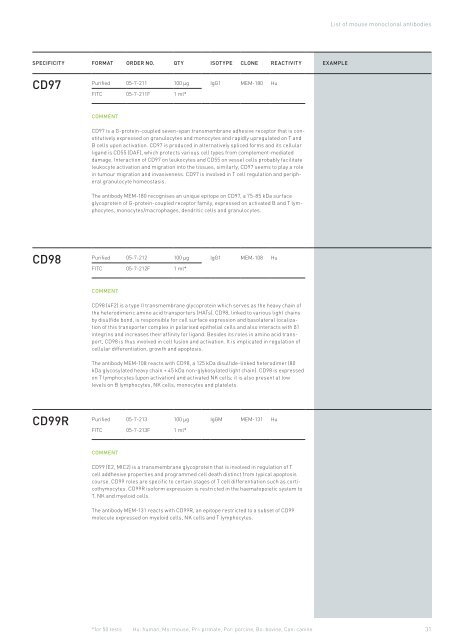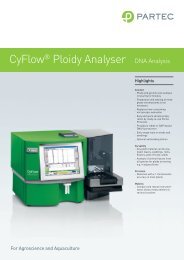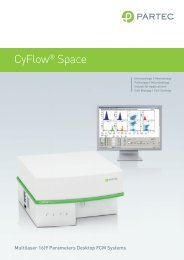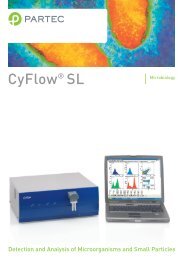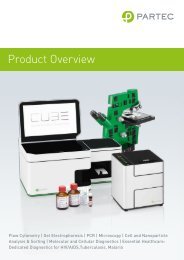Partec Reagents & mAb Catalog
Partec Reagents & mAb Catalog
Partec Reagents & mAb Catalog
Create successful ePaper yourself
Turn your PDF publications into a flip-book with our unique Google optimized e-Paper software.
sPecificity format order no. Qty isotyPe clone reactivity examPle<br />
cd97 Purified 05-7-211 100 µg IgG1 MEM-180 Hu<br />
FITC 05-7-211F 1 ml*<br />
comment<br />
CD97 is a G-protein-coupled seven-span transmembrane adhesive receptor that is constitutively<br />
expressed on granulocytes and monocytes and rapidly upregulated on T and<br />
B cells upon activation. CD97 is produced in alternatively spliced forms and its cellular<br />
ligand is CD55 (DAF), which protects various cell types from complement-mediated<br />
damage. Interaction of CD97 on leukocytes and CD55 on vessel cells probably facilitate<br />
leukocyte activation and migration into the tissues, similarly, CD97 seems to play a role<br />
in tumour migration and invasiveness. CD97 is involved in T cell regulation and peripheral<br />
granulocyte homeostasis.<br />
The antibody MEM-180 recognises an unique epitope on CD97, a 75-85 kDa surface<br />
glycoprotein of G-protein-coupled receptor family, expressed on activated B and T lymphocytes,<br />
monocytes/macrophages, dendritic cells and granulocytes.<br />
cd98 Purified 05-7-212 100 µg IgG1 MEM-108 Hu<br />
FITC 05-7-212F 1 ml*<br />
comment<br />
CD98 (4F2) is a type II transmembrane glycoprotein which serves as the heavy chain of<br />
the heterodimeric amino acid transporters (HATs). CD98, linked to various light chains<br />
by disulfide bond, is responsible for cell surface expression and basolateral localization<br />
of this transporter complex in polarised epithelial cells and also interacts with β1<br />
integrins and increases their affinity for ligand. Besides its roles in amino acid transport,<br />
CD98 is thus involved in cell fusion and activation. It is implicated in regulation of<br />
cellular differentiation, growth and apoptosis.<br />
The antibody MEM-108 reacts with CD98, a 125 kDa disulfide-linked heterodimer (80<br />
kDa glycosylated heavy chain + 45 kDa non-glykosylated light chain). CD98 is expressed<br />
on T lymphocytes (upon activation) and activated NK cells; it is also present at low<br />
levels on B lymphocytes, NK cells, monocytes and platelets.<br />
cd99r Purified 05-7-213 100 µg IgGM MEM-131 Hu<br />
FITC 05-7-213F 1 ml*<br />
comment<br />
CD99 (E2, MIC2) is a transmembrane glycoprotein that is involved in regulation of T<br />
cell addhesive properties and programmed cell death distinct from typical apoptosis<br />
course. CD99 roles are specific to certain stages of T cell differentiation such as corticothymocytes.<br />
CD99R isoform expression is restricted in the haematopoietic system to<br />
T, NK and myeloid cells.<br />
The antibody MEM-131 reacts with CD99R, an epitope restricted to a subset of CD99<br />
molecule expressed on myeloid cells, NK cells and T lymphocytes.<br />
*for 50 tests<br />
Hu: human, Ms: mouse, Pri: primate, Por: porcine, Bo: bovine, Can: canine<br />
List of mouse monoclonal antibodies<br />
31


